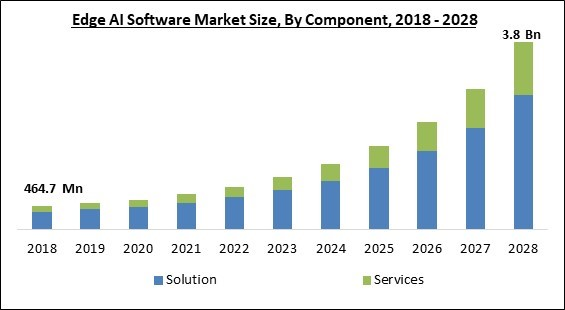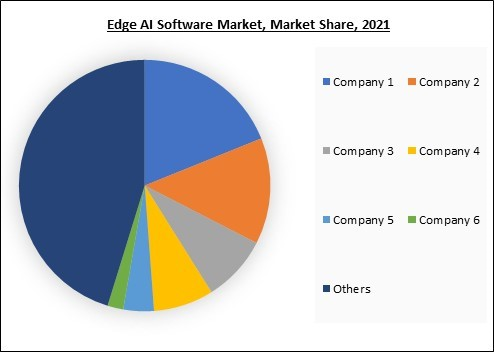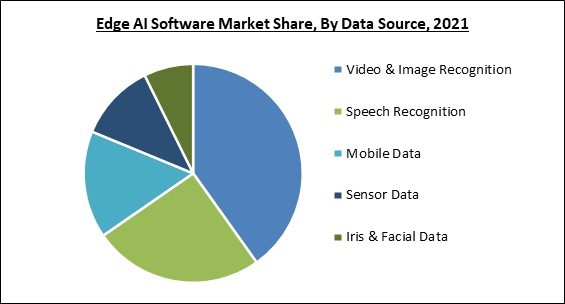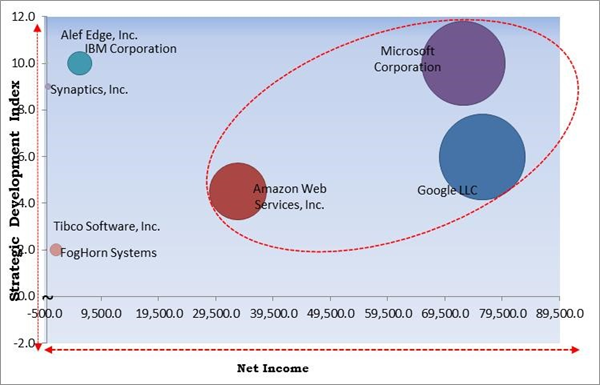The Global Edge AI Software Market size is expected to reach $3.8 billion by 2028, rising at a market growth of 27.8% CAGR during the forecast period.
Edge AI software consists of numerous machine-learning algorithms which are executed on physical hardware. Running AI algorithms on a local machine or device is the premise. Because Edge AI software can connect to consumers without the usage of other systems or the internet, users may access data instantly. Artificial intelligence combined with edge computing is known as edge AI.
The machine learning methods used in Edge AI are executed right at the edge. Edge computing is the direct processing of data and information at the IoT unit or device or the edge. Because of its intrinsic benefits, such as real-time analytics, high speed, reduced latency, etc., edge computing is expanding quickly.
The machine learning techniques used in Edge AI systems can be run on current CPUs or even less powerful microcontrollers (MCUs) in edge devices. Edge AI offers higher performance while also consuming less power as compared to other applications that make use of highly effective AI devices.
Edge computing is the phrase for processing that considers a particular point of view. It brings data nearer to the equipment or point of information where it is most frequently required. Instead of being transported over vast distances to data centers or the cloud, edge computing enables IoT data to be handled close to its source. It relates to managing persistent data close to the data source, which is referred to as the association's "edge."It is linked to active applications as nearby as is practical to the location where the data is created rather than a cloud or data collection area.
The leading players in the market are competing with diverse innovative offerings to remain competitive in the market. The below illustration shows the percentage of revenue shared by some of the leading companies in the market. The leading players of the market are adopting various strategies in order to cater demand coming from the different industries. The key developmental strategies in the market are Partnerships & Collaborations.
The major strategies followed by the market participants are Partnerships. Based on the Analysis presented in the Cardinal matrix; Microsoft Corporation and Google LLC are the forerunners in the Edge AI Software Market. Companies such as Amazon Web Services, Inc., IBM Corporation, FogHorn Systems are some of the key innovators in Edge AI Software Market.
The market research report covers the analysis of key stake holders of the market. Key companies profiled in the report include Microsoft Corporation, IBM Corporation, Google LLC, Amazon Web Services, Inc. (Amazon.com, Inc.), Nutanix, Inc., Tibco Software, Inc. (Vista Equity Partners), Synaptics, Inc., FogHorn Systems (Johnson Controls), Azion Technologies, Inc., and Alef Edge, Inc.
Edge AI software consists of numerous machine-learning algorithms which are executed on physical hardware. Running AI algorithms on a local machine or device is the premise. Because Edge AI software can connect to consumers without the usage of other systems or the internet, users may access data instantly. Artificial intelligence combined with edge computing is known as edge AI.
The machine learning methods used in Edge AI are executed right at the edge. Edge computing is the direct processing of data and information at the IoT unit or device or the edge. Because of its intrinsic benefits, such as real-time analytics, high speed, reduced latency, etc., edge computing is expanding quickly.
The machine learning techniques used in Edge AI systems can be run on current CPUs or even less powerful microcontrollers (MCUs) in edge devices. Edge AI offers higher performance while also consuming less power as compared to other applications that make use of highly effective AI devices.
Edge computing is the phrase for processing that considers a particular point of view. It brings data nearer to the equipment or point of information where it is most frequently required. Instead of being transported over vast distances to data centers or the cloud, edge computing enables IoT data to be handled close to its source. It relates to managing persistent data close to the data source, which is referred to as the association's "edge."It is linked to active applications as nearby as is practical to the location where the data is created rather than a cloud or data collection area.
COVID-19 Impact Analysis
The COVID-19 outbreak has significantly impacted sectors like aerospace, transportation, manufacturing, and food and beverage. The Covid-19 pandemic epidemic has had a devastating effect on a number of sectors, but it has had a favorable effect on the market for edge AI software. Numerous businesses and organizations had to close their doors in order to stop the deadly coronavirus from spreading. Many firms made the switch to adopting cutting-edge AI software during this time in order to fully automate work processes and to easily and remotely monitor the workflow. These elements have accelerated the market's vertical growth during the crisis.Market Growth Factors
Enterprise Workloads Are Expanding Quickly in The Cloud
Due to the quick uptake of cloud computing, everyday data transfers to the cloud are expected to result in an increase in cloud workloads. Organizations can store and retrieve data on edge nodes and devices that require a real-time reaction and are needed for a brief period of time, thanks to edge AI software solutions. With the rise of multiple applications across numerous industries, AI is expanding significantly. For tasks like real-time data processing and data capture, these apps need a lot of computational power to deliver effective and useful results.The Development of A 5g Network Will Unite It and Telecom
The development of a 5G network will unite IT and telecom. With regard to delivering ultra-low latency throughout edge devices like drones, telesurgery equipment, self-driving cars, IoT gateways, etc., 5G is anticipated to emerge as a powerful technology enabler. Next-generation edge devices will proliferate as a result of the deployment and adoption of 5G, revolutionizing workload and productivity across several industries.The leading players in the market are competing with diverse innovative offerings to remain competitive in the market. The below illustration shows the percentage of revenue shared by some of the leading companies in the market. The leading players of the market are adopting various strategies in order to cater demand coming from the different industries. The key developmental strategies in the market are Partnerships & Collaborations.
Market Restraining Factor
Edge Ai Solutions Raise Privacy and Security Problems
AI systems must be created, managed, and implemented by qualified professionals. The use of technologies like machine learning, cognitive computing, image recognition, and deep learning should be understood by everyone working with AI systems. Additionally, integrating AI technologies with current systems is a challenging undertaking that needs a lot of data processing. Even slight mistakes can cause a system to malfunction or fail, which can have an impact on how a process turns out. To modify an existing ML-enabled AI service, qualified data scientists and developers are needed.Components Outlook
On the basis of components, the market is divided into Solutions and Services. The Solutions category attained the highest market share in 2021. Edge AI software solutions help businesses automate administrative procedures, boost productivity, and cut expenses. In addition to training and consultation, system integration and testing, support and maintenance are among the services offered by Edge AI software solutions, which comprise both integrated and standalone solutions.Data Source Outlook
On the basis of data source, the market is divided into categories for video and image recognition, iris and facial data, mobile data, sensor data, and speech recognition. Mobile data is expected to have the highest CAGR in 2021 out of all the forecasted segments. As computing becomes more pervasive in all facets of life, phones, tablets, and wearable technology are able to do new tasks. To support the need for computationally intensive applications among mobile users, such as virtual reality and real-time online gaming, computing requirements for mobile applications are fast rising.Organization Size Outlook
On the basis of organization size, the market is divided into large Enterprises and SMEs. During the anticipated timeframe, SMEs are showing encouraging growth. SMEs are businesses with between 1 and 1,000 employees, whereas large businesses have more than 1,000 employees. SMEs frequently lack the tools and resources necessary for efficient marketing orchestration in addition to having a small marketing budget. SMEs attempt to scale up their businesses on a tight budget using methods that maximize return on investment.Deployment Mode Outlook
On the basis of deployment mode, the market is divided into On-premises and Cloud. In the market for edge AI software, the on-premises segment is displaying largest revenue share. There is a vast ecosystem of tools available that were created for on-site use and can operate with high levels of computational power, which is sometimes pricey in the cloud. Some clients believe that doing this on-site is more cost-effective, or they favor a capital expense model over an operational expense one.Vertical Outlook
On the basis of vertical, public and government sectors, manufacturing, healthcare and life sciences, energy and utilities, telecom, media and entertainment, transportation and logistics, and others. Healthcare & Life Sciences is projected to have a potential revenue share in 2021. By using more specific and precise real-time data processing, AI technology aids in the diagnosis and identification of a variety of ailments. A person's capacity to speak, move, engage, and react is limited by neurological illnesses. AI-based brain-computer interfaces can assist a person in carrying out basic tasks.Regional Outlook
On the basis of geography, the market is divided into North America, Europe, Asia Pacific, and LAMEA. During the anticipated time, North America's market will be the largest. Among all the geographical areas, North America has one of the highest rates of edge AI software use. The US and Canada are the top two nations fueling the expansion of the edge AI software market. Businesses in this region, particularly those in the US, have taken advantage of AI, ML, and deep learning technology to stay ahead of the competition.The Cardinal Matrix - Edge AI Software Market Competition Analysis
The major strategies followed by the market participants are Partnerships. Based on the Analysis presented in the Cardinal matrix; Microsoft Corporation and Google LLC are the forerunners in the Edge AI Software Market. Companies such as Amazon Web Services, Inc., IBM Corporation, FogHorn Systems are some of the key innovators in Edge AI Software Market.
The market research report covers the analysis of key stake holders of the market. Key companies profiled in the report include Microsoft Corporation, IBM Corporation, Google LLC, Amazon Web Services, Inc. (Amazon.com, Inc.), Nutanix, Inc., Tibco Software, Inc. (Vista Equity Partners), Synaptics, Inc., FogHorn Systems (Johnson Controls), Azion Technologies, Inc., and Alef Edge, Inc.
Recent Strategies Deployed in Edge AI Software Market
Partnerships, Collaborations and Agreements:
- Sep-2022: Amazon Web Services collaborated with SK Telecom, the information and communications technology division of SK Group. SK Telecom is a South Korea-based telecommunications firm. Under this collaboration, both organizations would work together to develop new computer vision services, which include optimizing classification, extraction, and analysis to derive insights from images. The integration of SK's expertise in AI and AWS's scalability, and elasticity would advance innovation in AI. Additionally, this collaboration would make computer vision applications easier and more economical to develop, use and advance.
- Mar-2022: Microsoft extended its partnership with AT&T, a US-based global telecommunications company, providing internet access, security, private networking, etc. services. This partnership involves a service named AT&T Private 5G Edge, which is co-developed by Microsoft. AT&T Private 5G Edge, a platform that uses CBRS and AT&T spectrum. Microsoft along with AT&T aims to advance the consolidation that private wireless solutions require, increasing the speed of deployment. Additionally, under this partnership, both organizations would work on AT&T Private Edge.
- Jan-2022: Amazon Web Services extended its partnership with Telenor, a Norwegian-based state-owned telecommunications company, providing data, communication, and telecom services. The extended partnership between AWS and Telenor involves jointly investing in go-to-market activities in various industries including, manufacturing, logistics, supply chain, etc. Additionally, with this partnership, both companies aim to develop the telecommunications industry.
- Sep-2021: Synaptics partnered with Edge Impulse, a US-based firm, providing Machine Learning Solutions. This partnership integrates Synaptics’ Katana™ Ultra Low-Power Edge AI Platform and Edge Impulse's software development platform. This combination provides Synaptics' clients to develop custom models for the Katana platform that would significantly upgrade time to market for battery-powered connected devices at the edge.
- Feb-2021: FogHorn teamed up with IBM, a US-based technology company, primarily into providing software, IT services, hardware, consulting, etc. FogHorn would cash on IBM's cloud expertise, which would enable FogHorn to better serve its clients by enabling them to make well-informed decisions with their data immediately. Additionally, this partnership enables FogHorn to reduce waste, energy consumption, and better up-time.
- Jan-2021: AlefEdge partnered with Netris, a US-based company, providing a cloud-like platform that allows networking and non-networking people to have authority over applications. This partnership provides users with an important tool that allows them to build and manage applications and services.
- Sep-2020: AlefEdge partnered with NTT, a Japan-based global company providing, information technology and consulting services. This partnership would improve the capability to develop edge applications and has the potential to significantly transform everything IoT, social media, etc.
- Sep-2020: AlefEdge came into partnership with NetFoundry, a distributed company providing an open source zero trust networking platform. This partnership integrates NetFoundry’s architecture and AlefEdge's Defined Mobile Edge (SD-ME) platform, enabling AlefEdge to offer organizations to create secure 5G-like applications.
- Jul-2020: IBM teamed up with EY, a Big 4 accounting firm providing a wide variety of services including, assurance, taxation, valuations, risk management, etc. to organizations across the world. This collaboration involves integrating EY's regulatory knowledge, strategy, and business consulting expertise with IBM's technology and hybrid cloud portfolio to advance IBM's clients toward the cloud and help them update and modify their businesses.
- Jul-2020: Google partnered with Orange, a France-based global telecommunications company, primarily into providing cloud computing, network, data, and analytics services. This partnership integrates Google's expertise in cloud technologies, analytics, AI, and Orange's know-how in information, and communication technology services. Additionally, this strategic partnership strengthens Google Cloud's market position in Europe.
- Jul-2020: TIBCO teamed up with Microsoft, a US-based global technology company, providing consumer electronics, personal computers, accessories, etc. This collaboration involves the inclusion of Azure AI to TIBCO, providing customers with more flexibility, less time lag, etc.
- May-2020: IBM came into collaboration with NVIDIA intending to advance analytics and employ applications at the edge. NVIDIA, an American global technology company, provides integrated circuits, laptops, robotics and edge computing, etc. This collaboration integrated IBM's Edge Application Manager with NVIDIA's EGX to help its clients deliver next-generation IoT, 5G-based, and AI services.
Mergers and Acquisitions:
- Nov-2022: Synaptics acquired Emza Visual Sense, an Israel-based firm, primarily into providing visual sensors. This acquisition reinforces Synaptics' market position and allows it to introduce Human Presence Detection (HPD) solutions.
- May-2022: Google took over MobiledgeX, an edge computing firm providing a marketplace for edge computing resources and services. This acquisition aligns with Google's plan of action to become the open-source champion of operator cloud-native network transformation.
- Mar-2022: Microsoft acquired Nuance Communications, a US-based company that provides speech recognition solutions, healthcare AI solutions and omnichannel customer engagement. This acquisition enables healthcare services providers, a better opportunity to provide economical, attainable healthcare services, and allows organizations in other industries to better serve the needs of their clients.
- Feb-2022: AlefEdge acquired CareerGig, a marketplace engaged in linking freelancers with companies across all industries. This acquisition would lead to the first ever edge developer community, providing developers with the necessary tools to develop applications to improve private mobile networks.
- Mar-2021: Microsoft took over The Marsden Group, a global technology group, providing industrial technology. This acquisition strengthened Microsoft's potential to create customer value by experimenting and providing deep industry solutions formed on edge, Microsoft cloud, and AI.
Product Launches and Expansions:
- Oct-2022: IBM introduced three libraries in the Embeddable AI product portfolio. These three new libraries allow IBM's independent software partners and their development teams a trouble-free path to develop AI solutions through pre-trained models and runtime orchestration.
- Mar-2022: Synaptics launched the Edge AI evaluation kit (EVK), built on low-power Katana SoC. The Evaluation kit integrates sound, motion, and vision detection software and hardware with wireless and wired connections to untangle the development of edge AI. This product would complete a comprehensive portfolio including software, hardware, technical support, and wireless connectivity, benefitting Synaptics' clients by enabling them to get their IoT ideas to the market.
- Jun-2021: IBM introduced IBM Cloud Pak for Network Automation, a hybrid cloud AI-powered automation software intended to use by communications service providers (CSPs), and can run in varied environments. This product enables IBM to provide better services to its clients in the telco industry, by using AI-powered automation which solves the problem of limited automation and less real-time visibility.
Geographical Expansions:
- Feb-2022: Amazon Web Services expanded its global footprint by offering AWS Local Zones services in 32 new metropolitan areas in 26 countries across the world. AWS Local Zones are a kind of AWS infrastructure deployment that brings storage, computing, and other services closer to the end-users.
Scope of the Study
By Component
- Solution
- Services
By Data Source
- Video & Image Recognition
- Speech Recognition
- Mobile Data
- Sensor Data and Iris & Facial Data
By Deployment Mode
- On-premises
- Cloud
By Organization Size
- Large Enterprises
- Small & Medium Enterprises (SMEs)
By Vertical
- Telecom
- Government & Public Sector
- Manufacturing
- Energy & Utilities
- Travel & Hospitality
- Media & Entertainment
- Healthcare & Life Sciences
- Others
By Geography
- North America
- US
- Canada
- Mexico
- Rest of North America
- Europe
- Germany
- UK
- France
- Russia
- Spain
- Italy
- Rest of Europe
- Asia Pacific
- China
- Japan
- India
- South Korea
- Singapore
- Malaysia
- Rest of Asia Pacific
- LAMEA
- Brazil
- Argentina
- UAE
- Saudi Arabia
- South Africa
- Nigeria
- Rest of LAMEA
Key Market Players
List of Companies Profiled in the Report:
- Microsoft Corporation
- IBM Corporation
- Google LLC
- Amazon Web Services, Inc. (Amazon.com, Inc.)
- Nutanix, Inc.
- Tibco Software, Inc. (Vista Equity Partners)
- Synaptics, Inc.
- FogHorn Systems (Johnson Controls)
- Azion Technologies, Inc.
- Alef Edge, Inc.
Unique Offerings
- Exhaustive coverage
- The highest number of market tables and figures
- Subscription-based model available
- Guaranteed best price
- Assured post sales research support with 10% customization free
Table of Contents
Chapter 1. Market Scope & Methodology
Chapter 2. Market Overview
Chapter 3. Competition Analysis - Global
Chapter 4. Global Edge AI Software Market by Component
Chapter 5. Global Edge AI Software Market by Data Source
Chapter 6. Global Edge AI Software Market by Deployment Mode
Chapter 7. Global Edge AI Software Market by Organization Size
Chapter 8. Global Edge AI Software Market by Vertical
Chapter 9. Global Edge AI Software Market by Region
Chapter 10. Company Profiles
Companies Mentioned
- Microsoft Corporation
- IBM Corporation
- Google LLC
- Amazon Web Services, Inc. (Amazon.com, Inc.)
- Nutanix, Inc.
- Tibco Software, Inc. (Vista Equity Partners)
- Synaptics, Inc.
- FogHorn Systems (Johnson Controls)
- Azion Technologies, Inc.
- Alef Edge, Inc.
Methodology

LOADING...












